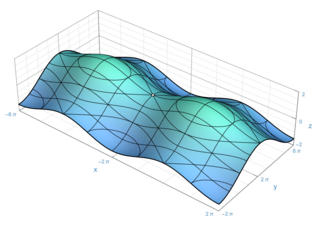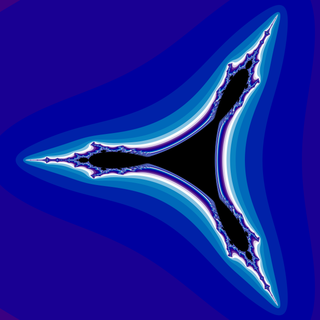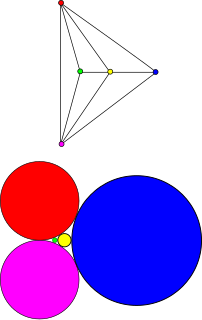Related Research Articles

In complex analysis, the Riemann mapping theorem states that if U is a non-empty simply connected open subset of the complex number plane C which is not all of C, then there exists a biholomorphic mapping f from U onto the open unit disk

In the part of mathematics referred to as topology, a surface is a two-dimensional manifold. Some surfaces arise as the boundaries of three-dimensional solids; for example, the sphere is the boundary of the solid ball. Other surfaces arise as graphs of functions of two variables; see the figure at right. However, surfaces can also be defined abstractly, without reference to any ambient space. For example, the Klein bottle is a surface that cannot be embedded in three-dimensional Euclidean space.

In mathematics, a conformal map is a function that locally preserves angles, but not necessarily lengths.

In mathematics, particularly in complex analysis, a Riemann surface is a connected one-dimensional complex manifold. These surfaces were first studied by and are named after Bernhard Riemann. Riemann surfaces can be thought of as deformed versions of the complex plane: locally near every point they look like patches of the complex plane, but the global topology can be quite different. For example, they can look like a sphere or a torus or several sheets glued together.
Algebraic K-theory is a subject area in mathematics with connections to geometry, topology, ring theory, and number theory. Geometric, algebraic, and arithmetic objects are assigned objects called K-groups. These are groups in the sense of abstract algebra. They contain detailed information about the original object but are notoriously difficult to compute; for example, an important outstanding problem is to compute the K-groups of the integers.
Complex dynamics is the study of dynamical systems defined by iteration of functions on complex number spaces. Complex analytic dynamics is the study of the dynamics of specifically analytic functions.

In the mathematical field of algebraic geometry, a singular point of an algebraic varietyV is a point P that is 'special', in the geometric sense that at this point the tangent space at the variety may not be regularly defined. In case of varieties defined over the reals, this notion generalizes the notion of local non-flatness. A point of an algebraic variety which is not singular is said to be regular. An algebraic variety which has no singular point is said to be non-singular or smooth.
In mathematics, a manifold is a topological space that locally resembles Euclidean space near each point. More precisely, an n-dimensional manifold, or n-manifold for short, is a topological space with the property that each point has a neighborhood that is homeomorphic to an open subset of n-dimensional Euclidean space.
In mathematics, Carathéodory's theorem is a theorem in complex analysis, named after Constantin Carathéodory, which extends the Riemann mapping theorem. The theorem, first proved in 1913, states that the conformal mapping sending the unit disk to the region in the complex plane bounded by a Jordan curve extends continuously to a homeomorphism from the unit circle onto the Jordan curve. The result is one of Carathéodory's results on prime ends and the boundary behaviour of univalent holomorphic functions.
In mathematics, Milnor maps are named in honor of John Milnor, who introduced them to topology and algebraic geometry in his book Singular Points of Complex Hypersurfaces and earlier lectures. The most studied Milnor maps are actually fibrations, and the phrase Milnor fibration is more commonly encountered in the mathematical literature. These were introduced to study isolated singularities by constructing numerical invariants related to the topology of a smooth deformation of the singular space.

Formula: z = conj(z2)+c
Brian Hayward Bowditch is a British mathematician known for his contributions to geometry and topology, particularly in the areas of geometric group theory and low-dimensional topology. He is also known for solving the angel problem. Bowditch holds a chaired Professor appointment in Mathematics at the University of Warwick.

The circle packing theorem describes the possible tangency relations between circles in the plane whose interiors are disjoint. A circle packing is a connected collection of circles whose interiors are disjoint. The intersection graph of a circle packing is the graph having a vertex for each circle, and an edge for every pair of circles that are tangent. If the circle packing is on the plane, or, equivalently, on the sphere, then its intersection graph is called a coin graph; more generally, intersection graphs of interior-disjoint geometric objects are called tangency graphs or contact graphs. Coin graphs are always connected, simple, and planar. The circle packing theorem states that these are the only requirements for a graph to be a coin graph:
In mathematical analysis, a domain or region is a non-empty connected open set in a topological space, in particular any non-empty connected open subset of the real coordinate space Rn or the complex coordinate space Cn. This is a different concept than the domain of a function, though it is often used for that purpose, for example in partial differential equations and Sobolev spaces.
In mathematics, the Schoenflies problem or Schoenflies theorem, of geometric topology is a sharpening of the Jordan curve theorem by Arthur Schoenflies. For Jordan curves in the plane it is often referred to as the Jordan–Schoenflies theorem.
In mathematics, the measurable Riemann mapping theorem is a theorem proved in 1960 by Lars Ahlfors and Lipman Bers in complex analysis and geometric function theory. Contrary to its name, it is not a direct generalization of the Riemann mapping theorem, but instead a result concerning quasiconformal mappings and solutions of the Beltrami equation. The result was prefigured by earlier results of Charles Morrey from 1938 on quasi-linear elliptic partial differential equations.
In mathematics, the Loewner differential equation, or Loewner equation, is an ordinary differential equation discovered by Charles Loewner in 1923 in complex analysis and geometric function theory. Originally introduced for studying slit mappings, Loewner's method was later developed in 1943 by the Russian mathematician Pavel Parfenevich Kufarev (1909–1968). Any family of domains in the complex plane that expands continuously in the sense of Carathéodory to the whole plane leads to a one parameter family of conformal mappings, called a Loewner chain, as well as a two parameter family of holomorphic univalent self-mappings of the unit disk, called a Loewner semigroup. This semigroup corresponds to a time dependent holomorphic vector field on the disk given by a one parameter family of holomorphic functions on the disk with positive real part. The Loewner semigroup generalizes the notion of a univalent semigroup.
In mathematics, a quasicircle is a Jordan curve in the complex plane that is the image of a circle under a quasiconformal mapping of the plane onto itself. Originally introduced independently by Pfluger (1961) and Tienari (1962), in the older literature they were referred to as quasiconformal curves, a terminology which also applied to arcs. In complex analysis and geometric function theory, quasicircles play a fundamental role in the description of the universal Teichmüller space, through quasisymmetric homeomorphisms of the circle. Quasicircles also play an important role in complex dynamical systems.
In mathematics, a planar Riemann surface is a Riemann surface sharing the topological properties of a connected open subset of the Riemann sphere. They are characterized by the topological property that the complement of every closed Jordan curve in the Riemann surface has two connected components. An equivalent characterization is the differential geometric property that every closed differential 1-form of compact support is exact. Every simply connected Riemann surface is planar. The class of planar Riemann surfaces was studied by Koebe who proved in 1910, as a generalization of the uniformization theorem, that every such surface is conformally equivalent to either the Riemann sphere or the complex plane with slits parallel to the real axis removed.

In mathematics, the Schwarz triangle tessellation was introduced by H. A. Schwarz as a way of tessellating the hyperbolic upper half plane by a Schwarz triangle, i.e. a geodesic triangle in the upper half plane with angles which are either 0 or of the form π over a positive integer greater than one. Through successive hyperbolic reflections in its sides, such a triangle generates a tessellation of the upper half plane. The hyperbolic refections generates a discrete group, with an orientation-preserving normal subgroup of index two. Each such tessellation yields a conformal mapping of the upper half plane onto the interior of the geodesic triangle, generalizing the Schwarz–Christoffel mapping, with the upper half plane replacing the complex plane. The corresponding inverse function, first defined by Schwarz, solved the problem of uniformization a hyperbolic triangle and is called the Schwarz triangle function.
References
This article includes a list of general references, but it remains largely unverified because it lacks sufficient corresponding inline citations .(May 2010) |
This article incorporates material from the Citizendium article "Prime ends", which is licensed under the Creative Commons Attribution-ShareAlike 3.0 Unported License but not under the GFDL.
- Epstein, D. B. A. (3 May 1981), "Prime Ends", Proceedings of the London Mathematical Society , Oxford: Oxford University Press, s3–42 (3): 385–414, doi:10.1112/plms/s3-42.3.385, MR 0614728, Zbl 0491.30027 .
- Milnor, John (2006) [1999], Dynamics in one complex variable, Annals of Mathematics Studies, vol. 160 (3rd ed.), Princeton, NJ: Princeton University Press, pp. viii+304, doi:10.1515/9781400835539, ISBN 0-691-12488-4, MR 2193309, Zbl 1281.37001 , ISBN 978-0-691-12488-9,
- "Limit elements", Encyclopedia of Mathematics , EMS Press, 2001 [1994]